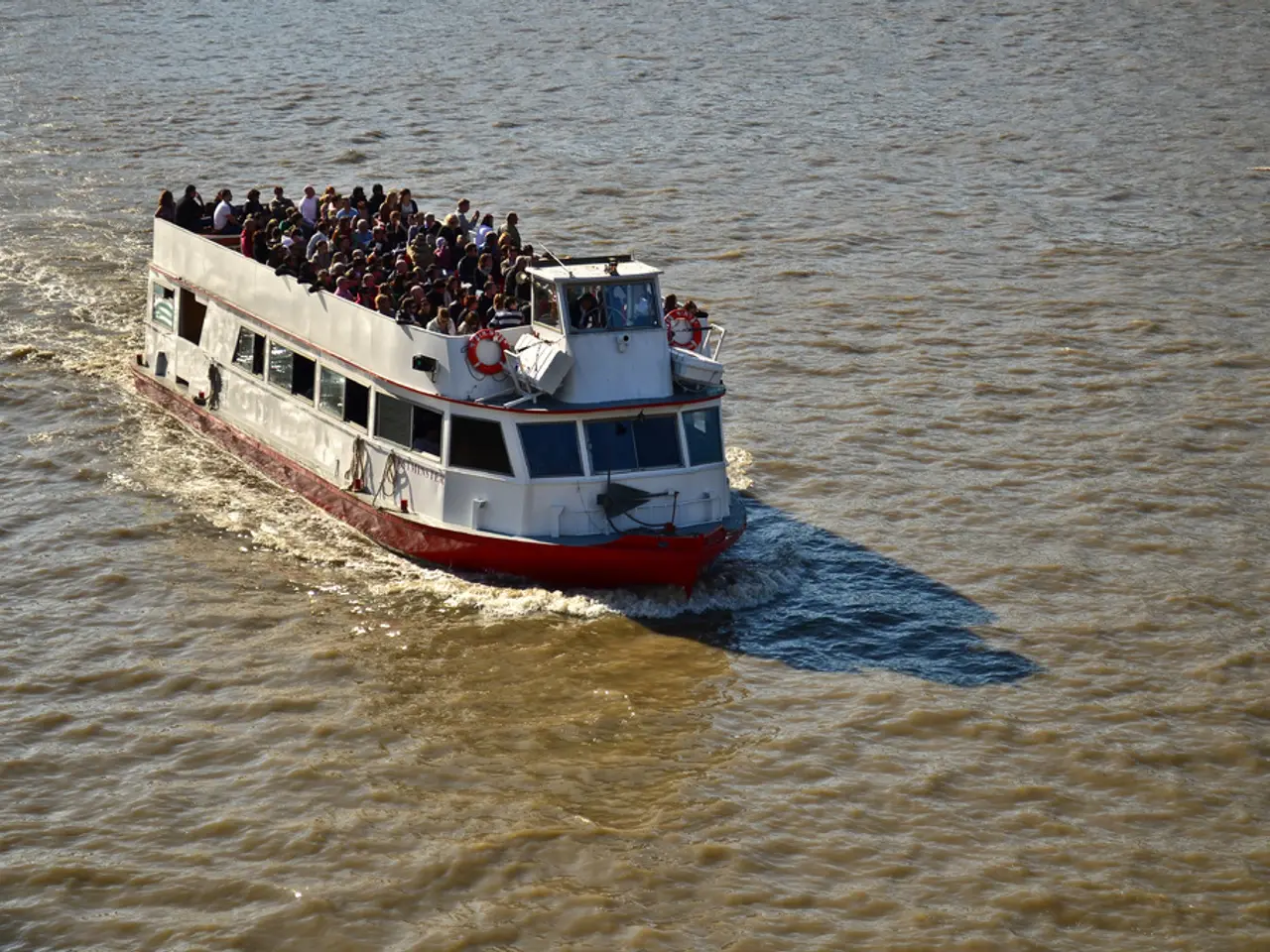Navigating Chaos: Shipping Firms Confront Trump's Tariff Turbulence
Trump's actions thrust shipping firms into a state of "disorderly disruption"
In the face of Trump's capricious trade policies, shipping companies are battling a whirlwind of uncertainty, particularly with the steep tariffs on Chinese imports. Anders Boenaes, a Dane responsible for Hapag-Lloyd's liner network, compares the current situation to an "unending organized chaos."
Boenaes, a five-year Hapag veteran and former Maersk employee, has maneuvered the firm's fleet of over 300 ships through the trade policy storm. The rollercoaster of tariff threats, impositions, and suspensions has led to wild swings in demand, especially on crucial U.S. routes that expose Hapag-Lloyd to substantial turmoil.
"The last six months I'd call it a continuation of the organized chaos we've experienced to some extent during the pandemic," says Boenaes. However, today's shipping climate isn't as dire as it was during the pandemic, assures the seasoned liner shipping and strategic network design expert. The industry has learned to be more adaptable in its day-to-day operations since the pandemic.
Plans aren't lodged away in a myriad of emergency folders for every hypothetical or outlandish scenario, Boenaes claims. Rather, it's about gauging demand and taking practical steps to adjust accordingly. For example, a 10,000 standard container (TEU) ship slated for Los Angeles could, if necessary, be reassigned to another route with an 8,000 or 6,000 TEU ship taking its place. Generally, the larger vessels are more profitable elsewhere.
The shipping sector handles approximately 90% of global trade and is no stranger to volatility. However, the current climate is characterized by exceptional unpredictability, says the Association of German Shipowners (VDR). “Companies are forced to act before the rules are clearly defined,” laments VDR spokesman Carsten Duif, also citing threatened US port fees. “Navigating in the fog of uncertainty" aptly sums up the industry's predicament due to Trump's inconsistent trade policies.
This unpredictability makes long-term fleet and capacity planning significantly more challenging, explains Duif. The ceaseless reacting to political announcements leads to inefficiencies, such as fluctuating utilization, ghost voyages, and ship space shortages when customers rush to transport goods before tariffs take effect. Shipping companies must often reroute ships, alter routes, or suspend services at a moment's notice, requiring close coordination with customers, port authorities, and crews under extreme time pressure.
Overwhelmed at the Customs Door
Boenaes characterizes the liner services as a string of pearls, with each route served every week by the same-sized ship carrying roughly the same cargo from similar clients. If demand wanes, the traditional response is to cancel a ship, says the Senior Managing Director Network expert. Yet, this isn't an option for Hapag-Lloyd due to the priority it places on punctuality and schedule adherence as part of the Gemini cooperation with Maersk, which began in February 2025, shortly after Trump's inauguration. Both companies were revising their networks when customers were blindsided by the realties of US customs policies.
There were cancellations of up to 30% in U.S.-China bookings following special tariffs on various goods, as Hapag-Lloyd CEO Rolf Habben Jansen revealed in May 2025. Just as the dust settled, the situation took another twist: U.S. tariffs on goods "Made in China" were reduced for 90 days. Customers flocked to Hapag-Lloyd, forcing the company to rapidly reorganize its liner services, only to reverse the changes weeks later. Such agility strains even the resilient shipping industry.
The 90-day grace period for China ends in August 2025, while the EU's ends early in July. Boenaes prefers to focus on the present instead of debating potential futures, including when the Suez Canal might reopen. Ships have been avoiding the canal since the Houthi rebels, allied with Hamas in Yemen, have been attacking commercial ships in the Red Sea. "Suez has effectively become 'business as usual' for us, as we've been sailing the Cape of Good Hope for 18 months."
The tariff-driven demand fluctuations, delays, and supply chain complexities have prompted shipping companies to take various actions, such as monitoring and complying with tariff updates, diversifying supply chains, adjusting inventory and demand planning, focusing on cost management and efficiency, and maintaining strategic flexibility. While the unpredictability remains, Boenaes' philosophy remains steadfast: "No panic."
Sources: ntv.de, Elke Ahlswede, rts
Enrichment Data:
In the midst of Trump's unpredictable trade policies, shipping companies in 2025 are grappling with tangible impacts and implementing strategies to mitigate these challenges.
Current Impacts on Shipping Companies
- Contracting U.S. Container Imports: The initial surge in U.S. container imports stemming from tariff anticipation has dissipated, leading to a decline in volumes. For instance, container imports dropped nearly 10% in May 2025 [4].
- Compounded costs due to Tariff-Driven Risks: Tariffs on steel, aluminum, and other goods have introduced risk aversion in supply chains, resulting in subdued demand for shipping services with limited recovery in freight rates, thereby compressing margins in for-hire fleets and owner-operators [5].
- Complicated Value Chains: Tariffs are driving shifts in supply chains, intensifying costs, causing sourcing disruptions, and escalating compliance requirements. The implementation of reciprocal tariffs on imports starting April 2025 could lead to cascading tariffs, exponentially increasing duties for importers [1][3].
- Questionable Long-Term Demand: Business decisions concerning production relocation remain tentative due to uncertainty over tariff persistence, as tariffs may reverse based on political cycles. Such doubt suppresses significant investment or strategic shifts in supply chains that would otherwise impact shipping demand [2].
Strategies for Navigating Trade Policy Uncertainties
- Proactive Monitoring and Preparation: Shipping companies, along with their clients, are keenly watching tariff announcements and updates, preparing for contingencies by understanding tariff rates, affected goods, and country-specific policies [1].
- Supply Chain Diversification: To offset risks from tariffs on Chinese imports, companies are exploring alternative sourcing locations that aren't as heavily targeted or subject to reciprocal tariffs, reducing dependence on single trade routes or origin countries [3].
- Prudent Inventory and Demand Management: Businesses and freight handlers have adjusted inventories and import timing, as seen with the initial 2025 surge in frontloading. Future actions emphasize judicious inventory management to avoid sudden demand drops and shipping volume volatility [2][4].
- Cost Management and Efficiency Focus: With squeezed margins due to tariffs and increased costs, fleets and shippers are focusing on operational efficiencies and cost controls to maintain profitability amid lower demand and increased compliance costs [5].
- Tactical patience: Given the possibility of tariff reversals or changes with political shifts, many companies are adopting a cautious approach for major strategic moves, preserving flexibility to react swiftly as policies stabilize or evolve [2].
- In the midst of Trump's unpredictable trade policies, industries such as shipping, finance, and business are adapting to the tangible impacts, with shipping companies implementing strategies like proactive monitoring, supply chain diversification, prudent inventory management, focus on cost management, and tactical patience to mitigate these challenges.
- The current climate in the shipping industry, governed by exceptional unpredictability due to Trump's trade policies, requires companies to gauge demand and take practical steps to adjust accordingly, such as rerouting ships, altering routes, or suspending services, in order to navigate the fog of uncertainty.






